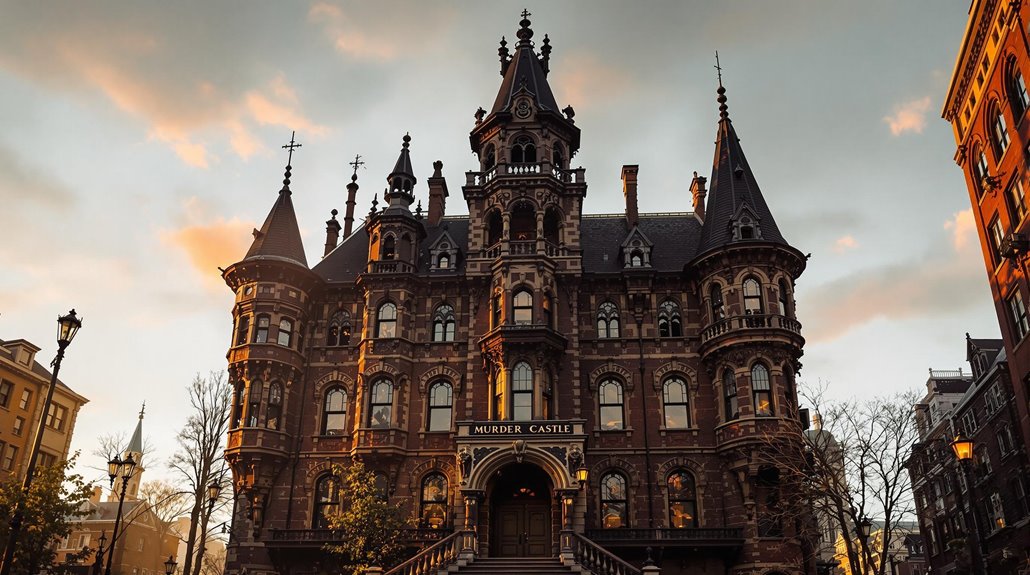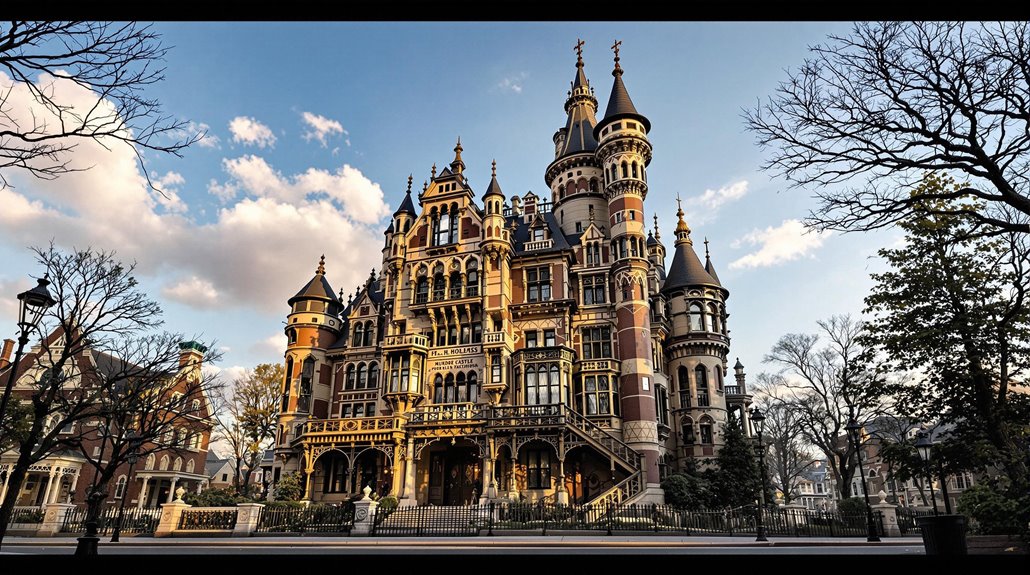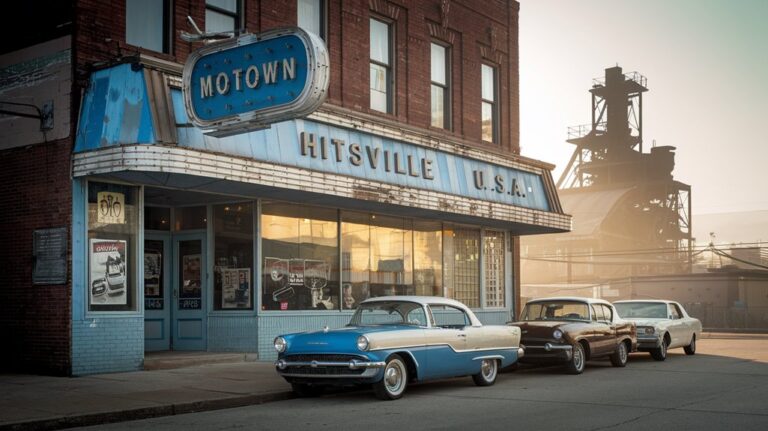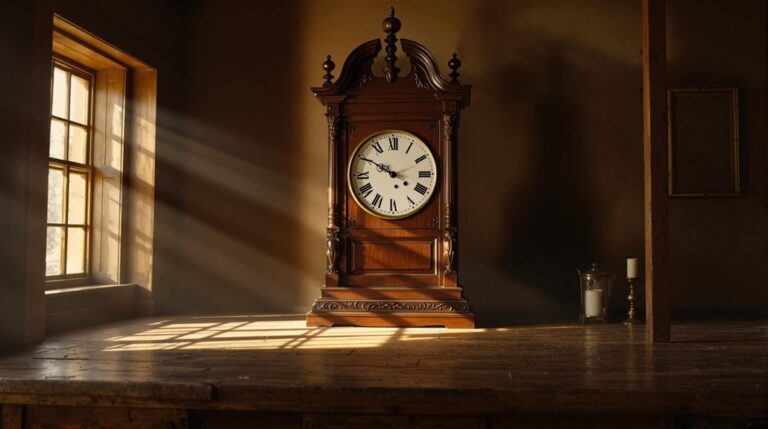The Murder Castle of H.H. Holmes: A Hotel of Horrors
Like a spider's web disguised as shelter, the Murder Castle of H.H. Holmes stands as America's most infamous architectural trap. You've probably heard whispers of this three-story Victorian nightmare, where hallways led nowhere and rooms held deadly secrets. Yet what you might not know is how meticulously Holmes engineered every detail of his Chicago death house, transforming a simple hotel into an elaborate killing machine. The true horrors that occurred behind those walls will challenge your understanding of human nature.
A Killer's Architectural Masterpiece
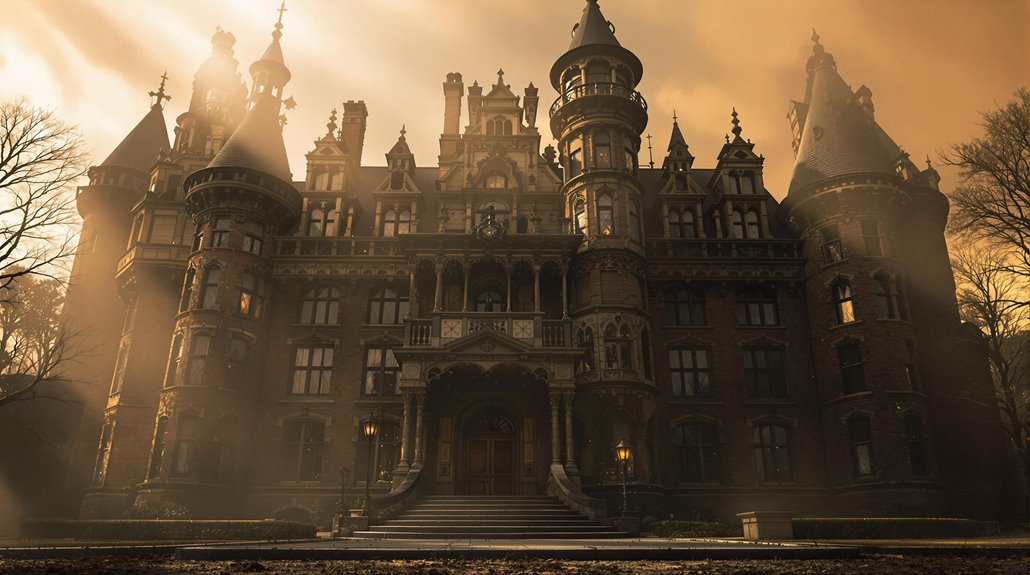
Standing at the corner of 63rd and Wallace Streets in Chicago, H.H. Holmes' three-story building appeared ordinary from the outside, but its interior held sinister secrets.
You'd never guess that behind the false battlements and iron-covered windows lay a labyrinth designed for murder.
As his own architect, Holmes crafted architectural deception into every floor. You'd find over 60 rooms connected by 51 oddly placed doors, creating a maze-like layout that could disorient anyone unfamiliar with its design.
The hidden features included trap doors, secret passages, and soundproofed rooms lined with asbestos-coated steel plates. Some rooms had no windows, while others featured chutes leading to the basement.
Most chilling was the staircase that opened to a deadly drop in the back alley – a detail that showcased Holmes' murderous architectural ingenuity.
Holmes specifically targeted guests during the 1893 World's Fair, when Chicago was flooded with visitors seeking accommodation.
He would later sell the skeletons to medical schools, disposing of his victims' remains through his basement morgue.
Deadly Design: Inside the Castle's Secret Chambers
While the Murder Castle's exterior masqueraded as an ordinary building, its interior held a network of chambers specifically engineered for killing.
You'd find asphyxiation rooms equipped with gas pipes and peepholes where Holmes watched his victims die. The castle's maze-like layout featured hidden passages behind false walls and sliding panels, allowing Holmes to move unseen between his private quarters and torture facilities.
In the basement, you'd discover a gruesome workshop complete with a dissecting table, acid vats, and a crematorium. Holmes lured many of his victims by offering them jobs at his pharmacy.
The upper floors housed an operating room and torture chamber filled with surgical instruments. Throughout the building, Holmes installed an intricate alarm system and deadly traps – from staircases leading nowhere to trapdoors dropping into body chutes below.
The World's Fair and Holmes' Perfect Hunting Ground
The 1893 World's Columbian Exposition transformed Chicago into H.H. Holmes' ideal hunting ground, though many urban myths have exaggerated his connection to the fair.
While over 27 million fair visitors flocked to the "White City," Holmes actually claimed only one confirmed victim, Nannie Williams, during the exposition.
You might be surprised to learn that Holmes' infamous "Castle" never truly operated as a hotel during the fair.
Instead, he used the event's massive tourist influx as cover for his fraudulent schemes. He'd advertise lodging vacancies and hire employees, only to fire them within two weeks to avoid paying wages. The building's mysterious layout included a glass-bending oven in the basement, which would later fuel speculation about his methods of disposal.
The hidden rooms in his building weren't torture chambers, as legend suggests, but rather storage for stolen furniture.
When the fair ended, Holmes left Chicago, though his crimes would continue elsewhere.
The Science of Murder: Tools and Techniques
Behind Holmes' ambitious criminal schemes lay a calculated methodology of murder that combined medical knowledge with architectural ingenuity.
You'd find his castle equipped with an arsenal of deadly tools: chloroform to subdue victims, surgical instruments for dissection, and gas jets installed in sealed chambers. Each room was strategically designed with soundproofing, peepholes, and trapdoors leading to the basement.
His disposal methods were equally methodical. Bodies traveled through chutes to a basement laboratory where Holmes would dissect them on a steel table. His education at the University of Michigan gave him the expertise needed for his gruesome work.
He'd strip flesh from bone using acid vats, then either cremate remains in his disguised furnace or sell the cleaned skeletons to medical schools. The entire building functioned as one massive death trap, with its maze-like layout designed to disorient and trap unsuspecting guests.
Death's Paper Trail: The Investigation and Aftermath
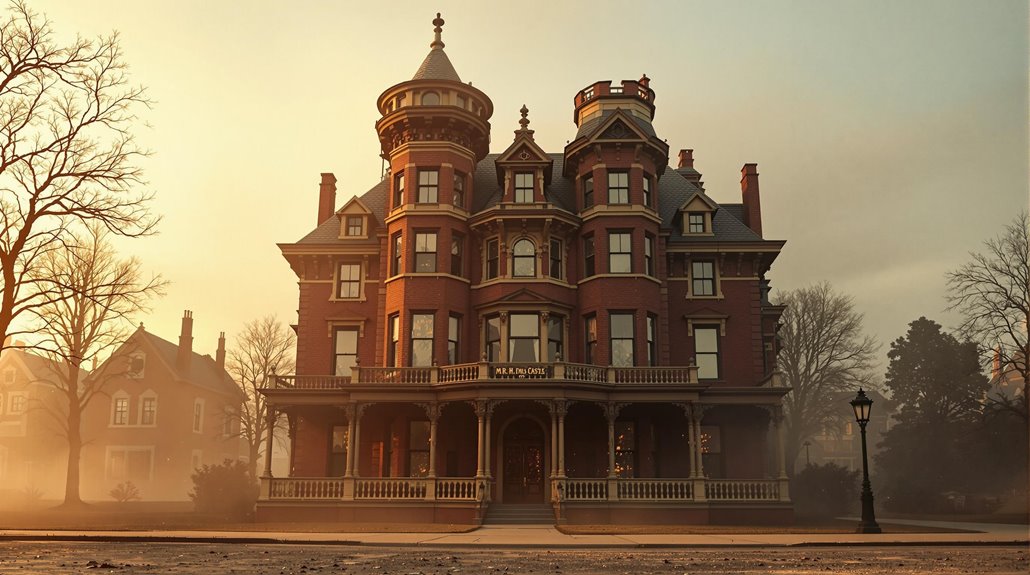
After years of undetected murders, Holmes's reign of terror unraveled through a seemingly minor horse theft case in Texas.
The Pinkerton Detective Agency tracked him to Boston, where they arrested him in November 1894. This arrest led investigators to uncover his elaborate insurance fraud scheme involving Benjamin Pitezel.
Detective Frank Geyer's relentless pursuit revealed the gruesome fates of the Pitezel children, with bodies discovered in Toronto and Indianapolis.
Though investigative techniques were primitive by today's standards, examination of Holmes's Chicago "Murder Castle" yielded essential forensic evidence: a human bone fragment, burned jewelry, and a tuft of female hair. The castle's hidden rooms contained gas connections and pipes designed specifically for murdering his victims.
You'll find the investigation's climax in Philadelphia, where Holmes faced trial for Pitezel's murder.
After his conviction, he confessed to 27 murders before his execution in 1896.

